Text
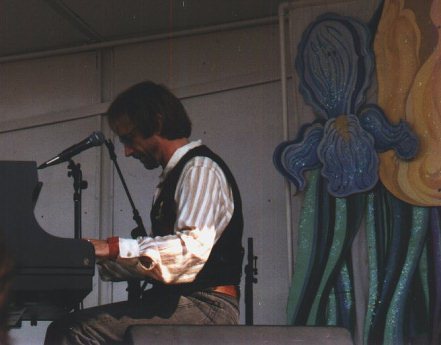
Photo courtesy of LAAC.
“Peter was a very gifted musician. He was part of an era of giants. He was a product of his time, when you look back at when the Monkees reached global fame and stardom.
He was great fun and a really talented pianist.” - Frankie Hepburn, Paisley Daily Express, February 25, 2019
11 notes
·
View notes
Text
"Cuckoo" live at the Lewisville Lawn Party in 1997. Footage courtesy of LAAC and torkwenches.
“[When I was about 14] I asked for a banjo, and they went out, my folks went out and bought me a little tiny, dinky five-string banjo. And Pete Seeger’s book, How To Play the Five-String Banjo, I think I bought that myself, and learned how to play from that. Nobody said, ‘Here, take a banjo,’ or, ‘Gee, you’d be good at it,’ or anything like that. I just wanted to play it.” - Peter Tork, Headquarters radio, 1989
“I’m a great admirer of Pete Seeger.“ - Peter Tork, Disc and Music Echo, January 13, 1968
“‘When I was a kid, before the Monkees, I was not primarily a rock and roller,’ said Tork during a 1998 interview. ‘I was primarily an acoustic folkie. For us, as acoustic folkies, the politics were very clear. We were strongly liberal, in the Pete Seeger mold. We certainly had a strong sense of right and wrong, and we certainly believed a lot that was wrong with society was the fault of the moneyed class. I think all of us to some extent believed ourselves to be socialists.’” - We all want to change the world: Rock and politics from Elvis to Eminem (2003)
18 notes
·
View notes
Text
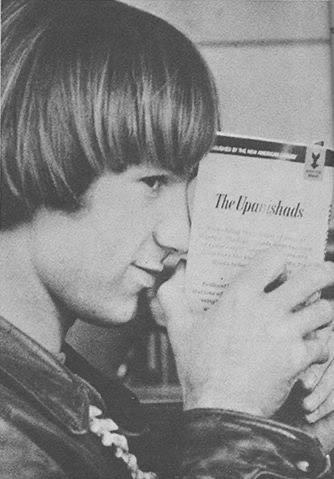
On the set of "The Wild Monkees," 1967.
"Peter Tork comes over and plops down next to you in a director's-type chair. He starts clowning around, but after a bit he settles down and starts reading a book. He sees you looking and explains, 'This is a book of some of the excerpts of the Upanishads. Actually, these are excerpts from ancient Hindu writings. I guess you could say that in a sense they are like the Bible, only they were written many centuries before the old testament.' Peter stops speaking for a moment. 'Am I boring you?' he asks gently. After you assure him that is not boring anyone, he continues, 'Well, the Upanishads are simply but beautifully written. I mean, they are quite easy to understand. You can buy the Mentor pocket edition for about 50 cents —'
Just about that time, Peter becomes aware of 16's camera focusing on him. He promptly becomes a clown again, laughing and joking and holding his book myopically up to his eyes. You realize that you have just had a glimpse of the real Peter Tork — the sensitive, sincere young man who hides behind the veneer of a silly-funny Monkee. And it makes you feel very warm that for a brief moment you have glimpsed Peter Tork's secret self." - Gloria Stavers, 16, February 1968
40 notes
·
View notes
Text

Photo by Polly Borland.
"Part of the liner notes [of Dreams In The Dust (The Last Dreams Before Forever)] will include special thanks to Peter Tork, one of The Monkees. He met Tork when that rock n’ roll band performed last month at Hershey Park.
'He spent 10-15 minutes talking to me,‘ [Terry] Jacques said. 'He had lost a friend to cancer.’" - York Daily Record, August 26, 1996
26 notes
·
View notes
Text

The Birds, The Bees & The Monkees was released on April 22, 1968.
To mark the occasion, here are three of Peter's songs - two written by him, one a cover - that didn't appear on the studio album but date from around this time:
"Come On In"
"Lady's Baby"
"Tear The Top Right Off My Head"
Q: “The Birds, The Bees & The Monkees sessions was a productive time in the studio for The Monkees. However, none of your stuff like ‘Lady’s Baby’ and ‘Tear The Top Right Off My Head’ made it to the album. How come?”
Peter Tork: “To tell you truth… I… I never was able in those days particularly — I’m getting better at it these days — but in those days I was almost entirely unable to fight for what I saw as quality. If I didn’t get somebody fighting on my behalf then it didn’t, just didn’t come to pass. And none of the other guys was much interested in supporting my sense of quality, they had their own agendas and each one of them… I mean, not that I was left out in this regard, no one of us really supported any of the others except that, that I like to think that I tried to support Micky in a way which, for some reason, he never did pick up on. I mean, I think that Micky has a certain kind of genius that he was never able to acknowledge in himself. But be any of that as it may, I just basically think that I wasn’t feeling a part of anymore already by that point, I’d already felt like I was odd man out, and of course I quit almost immediately thereafter. In fact, I think it’s The Birds, The Bees & The Monkees that has some tunes that were recorded after I quit.”
Q: “Peter, what’s the one thing you remember the most about The Birds & The Bees album?”
PT: “The thing I remember off Birds & Bees is that on the back, they had, you know, the four-petaled flower with the individual pictures, and each person put down a message. But I had a, like, almost a scowl on my face and I just didn’t have any message at all. That was me feeling… feeling, like, feeling pretty punk about the whole idea. I was — I was not happy. Not a happy Monkee in those days.” - Headquarters radio, September 1989
And, of course, the album also includes:
“With ‘Daydream Believer,’ I was on the piano and I came up with this opening lick which I thought was just sparklingly original. When you play it today, everyone thinks of ‘Daydream Believer.’” - Peter Tork, Rolling Stone, 2016
#Peter Tork#Tork quotes#60s Tork#Tork songs#The Monkees#Monkees#The Birds The Bees & The Monkees#long read#Peter deserved better#Daydream Believer#can you queue it
19 notes
·
View notes
Text
“Shades of Gray” — live on the Uncle Floyd Show in July 1980.
“[Peter] was obviously a bright guy and he was obviously a dedicated musician. He really brought Headquarters to life.” - Michael Nesmith, YouTube in memoriam for Peter
“Tork’s favorite Monkee album is their third, Monkees’ Headquarters, released in June 1967. ‘At that point we behaved like a musical group,’ he said. […] Tork feels [‘Shades of Gray‘] holds up to this day. ‘Mike wrote the cello and horn parts; he sang them to me and I wrote them on paper and we gave them to the musicians. I wrote a little piano lick at the top and played it. That was a record we created out of our own feelings. It’s like, not only are there shades of gray. God damn it, but what happened to the black and white? What happened to those clear-cut old ways that used to be?’” - When The Music Mattered (1984) (x)
#Peter Tork#Tork quotes#The Monkees#Monkees#80s Tork#Headquarters#Uncle Floyd Show#Peter Tork and the New Monks#Tork performances#can you queue it
15 notes
·
View notes
Text
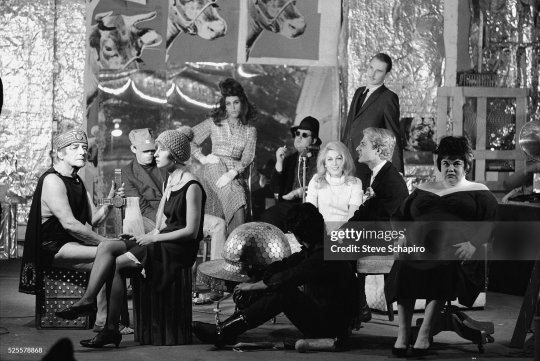



During research for any additional photos of Jody Babb (apart from the one published in 16 magazine in 1967; see this older post for that and for more about her relationship with Peter), I came across these photos from Jody's appearance in an Andy Warhol movie, Camp (1965). Photos by Steve Shapiro and Fred W. McDarrah.
"The first of Warhol’s new sync sound films to be shown in Los Angeles was 'Camp,' made late in 1965. It is essentially one unedited shot, interrupted only by one reel change. As the film begins, the performers are grouped in Warhol’s studio as are the figures in Courbet’s painting of 1855, 'L’Atelier,' which Courbet called 'the moral and physical history of my studio' (perhaps the parallels between the two works are more than superficial). There is no simple order to the arrangement: people are seated on a couch, on hard-backed wooden chairs, and on stools; they are standing against a wall in the background. The whole scene is lit with a garish melodrama created not only by stationary lights, but also by portable Sun-Guns carried about by T-shirted technicians who wander into the frame occasionally to light a certain spot or to move a microphone. The performers are listed in the program 'in order of appearance' as 'Baby Jane Holzer, Paul Swan, Mario Montez, Mar-Mar, Jody Babb, Tally Brown, Jack Smith, Fufu Smith, Donyle, Tosh Carillo, and your host, Gerard Malanga.' As this program note suggests, the format is that of a variety show. People are introduced and they perform and act for a set period of time.
[...]
Jody Babb has been sitting on a stool swinging her leg in studied nervousness. Now the microphone is brought over to her. She announces she is going to sing a song although she only knows part of it. She detaches the microphone from its stand and walks around singing 'Let Me Entertain You' in a halting, untrained voice. At one point she interrupts herself to give an aside, 'I’m bombing.' Actually she succeeds more than any of her predecessors in entertaining. In the middle of her act, the reel ends." - article by Thom Andersen, artforum dot com
“Jody’s reaction to the whole Monkee thing is she regards it only as public recognition of what she’s already known, as I do. She’s really capable of great business ability. If she took over an office, she’d make it a success. She already has. There’s a thing called Personality Posters for which she opened international offices.” - Peter Tork, Tiger Beat, July 1968
4 notes
·
View notes
Text


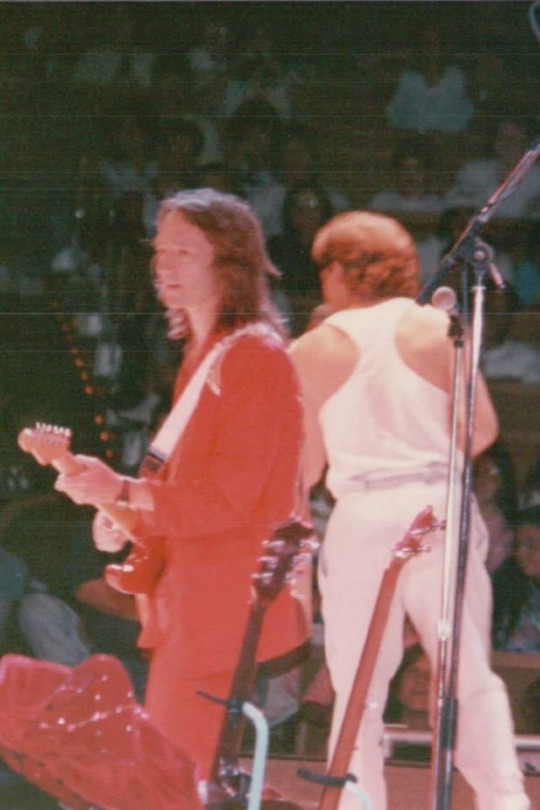

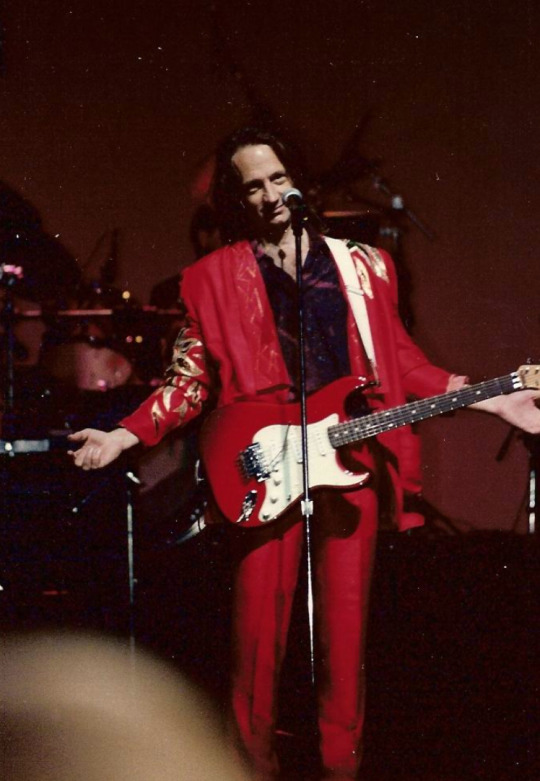
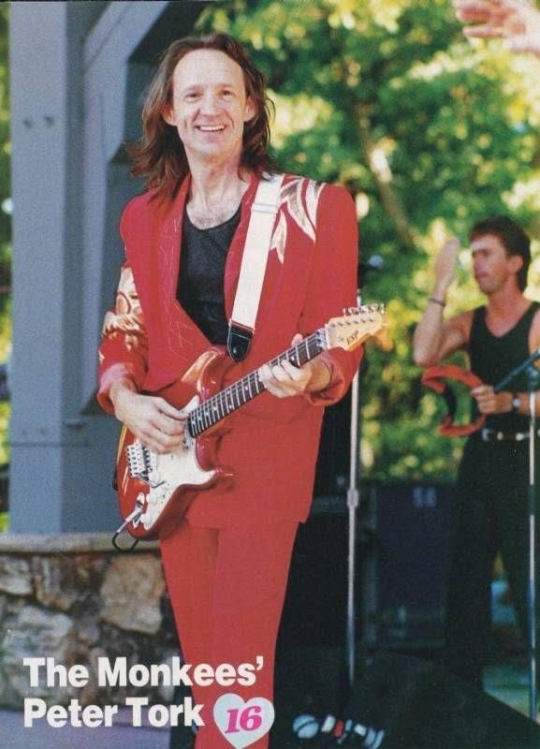



On tour, 1989. Photo credits as known: Cindy Andrew/Toronto Star via Getty Images, Cathy Whitehead, George Massina, Helen Pantuso.
“[Dolenz said, of a charity concert in London] 'We never mind doing anything for a good cause.’ Peter Tork carried on strumming on his guitar and Davy Jones (yes, he really is that small) relaxed the tense look on his face, briefly, to suggest that the song should be included in their forthcoming American tour. ‘It’s money for old rope,’ is how Micky Dolenz, who has the kind of face that could never look tense, summed up the group’s reformation.” - The Gazette, April 28, 1989
About the '80s tours stage costumes, designed and made by Peter's then-girlfriend Jennifer McLeod:
Q: "[A]t what point did you begin making costumes for the Monkees?"
Jennifer McLeod: "In 1987, in Australia. David Jones asked me if I would be interested. [...] I'd never really done anything for men before other than some stage costumes years ago. David asked me if I would be interested in doing the Monkees costumes for the '87 tour in the U.S. and I positively leapt at the chance. [...] I had [previously] made some clothes for Peter. [...] In '89, Micky and Trina specifically requested (tuxedo) tails... There was one sketch that I had done with tails. It had actually been done for David, and Micky said he would like tails too, so I modified a design I'd proposed for him and did it in tails."
Q: "The Monkees could make changes and you wouldn't be insulted?"
Jennifer McLeod: "No, not really. David, in '89, wanted a black version of the jacket I'd done for him in '87 with piano keys. So I did that. Peter came to me after he saw both Micky and Davy had black suits and said, 'I really want a black jacket as well.' So there was a certain give or take." - 16, May 1990
#Peter Tork#Tork quotes#Davy Jones#Micky Dolenz#The Monkees#Monkees#80s Monkees#Tork songs#Jennifer McLeod#can you queue it
46 notes
·
View notes
Text
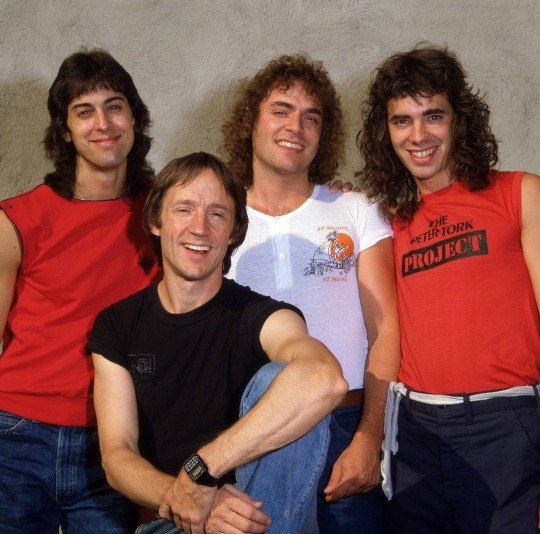
The Peter Tork Project. Photo by Michael Ventura.
Though I posted the photo previously (also with the watermarks removed), it's the only color photo of The Peter Tork Project that I know to be available online... so, here's a concert review to accompany it this time around:
“During the performance by THE PETER TORK PROJECT last Friday night at Patrix, there was a phalanx (yes, that is the proper word) of Monkees fans behind me who kept shouting, ‘DO MORE MONKEES SONGS!’ […]
I really wished the Monkees fans would have shut up.
[…] The PETER TORK PROJECT’s new material is strong enough to stand by itself.
If nothing else, it’s certainly different from The Monkees. Tork shows that his brain hasn’t been going soft in the years since he left the Monkees in 1969. He delivered his self-penned ‘U.S. Out of El Salvador’ (No draft no war U.S. out of El Salvador) with chant-like vocals reminiscent of a folkier Clash. […]
Though his patter between songs is still silly and self-deprecating, there’s a serious undertone to a lot of his material, to go with the added wrinkles on his face. He introduced one of his songs with ‘Here’s a song about life in the breakdown lane. You’ve heard about the fast lane. Well, this is what comes after that.’
The song was quite moving, definitely, I would venture, autobiographical. […]
Tork allowed the other band members to write their own material and do lead vocals on their individual songs, which is a refreshing blast of modesty from someone as famous as Tork. The band, as musicians, are just superb. Jerry Renino is a solid, supportive bassist, Derek Lord is a tight, showy drummer, and Scott Avitabile embodies the best of 60’s guitarists of the Black Sabbath variety to 70’s guitarist of the Van Halen variety. […]
THE PETER TORK PROJECT’s best original songs sound like [Neil] Young’s brilliant work from the mid-70’s with the band Crazy Horse. The songs have the same mellow, folkie vocals juxtaposed with crunching, almost heavy metal-like guitar playing.” - Bill Dale-Marcinko reviews The Peter Tork Project’s concert, The Central New Jersey Home News, September 29, 1983
#Peter Tork#Tork quotes#80s Tork#Tork reviews#The Peter Tork Project#Jerry Renino#Derek Lord#Scott Avitabile#long read#Tork songs#Tender Is#Tork performances#can you queue it
20 notes
·
View notes
Text

Photo by Nurit Wilde.
The ad in the Los Angeles Free Press dates the timeframe from April 14th-19th, 1970, but the Monkees Day-By-Day book lists April 17th-19th, 1970:
“Singer-guitarist Peter Tork, formerly of the Monkees, is performing this week at the Troubadour, replacing the originally scheduled Dion.” - Los Angeles Times, April 17, 1970
And yet another review that includes a disparaging remark: "forgettable originals" (the songs aren’t named, but it once again makes you wonder how the reviewers would fare trying to write any of the songs Peter wrote).
“[Peter performed at the Troubadour] as a last-minute replacement for Dion. He performed such standards as ‘Kansas City,’ ‘Blue Monday,’ ‘Get Back,’ and three forgettable originals.” - NME, June 23, 1970
#Peter Tork#Tork quotes#Tork reviews#70s Tork#Peter deserved better#Tork songs#(reviewers: go write For Pete's Sake and Can You Dig It and Long Title and Tender Is and any other Tork song and then try again)#can you queue it
16 notes
·
View notes
Photo


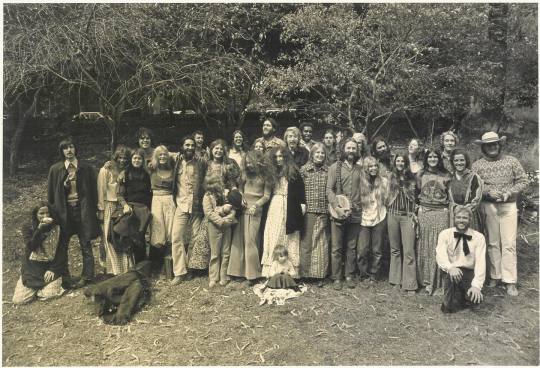

Peter Tork with the Fairfax Street Choir (in their bass vocal section); pictured in photo 1 with Ralph Pennuneri, Hosanna Bauer, and Bill Craig. Via the Fairfax Street Choir Facebook page, except for photo 4 (courtesy of Mark Kleiner).
Photo 2: “Peter Tork has his banjo but never played it with the choir that I remember but He was a really good musician and I remember him playing at the Lady. […] I’ve heard some of his live stuff on tape that he did at the Sleeping Lady and was blown away by how great he really was as a musician.” - Marla Hunt Hanson, Facebook, January 3, 2021
“Peter showed me some banjo picking patterns… he was a nice guy fun to play music with.” - David Carlson, Facebook, January 2021
“To us, he wasn’t famous, he was just Peter. […] He was just a sweet, dear man that, you know, everybody loved… He was just a good guy. You know, ‘Sleep on the couch, have a good one. You know, we love you. Come on in.’ […]
His destiny in this lifetime was with The Monkees. We were like his backup friends, or his backup band, whatever you want to call it.He came to us wounded, like a wounded bird, really. […] He never really got to escape from being one of The Monkees. It was very hard, you know, it was hard for him. I wish we could have given him more.
[…] I said to him, ‘Well, why are you going back when they treated you so badly, and blah blah blah?’ And he said, they offered him something he couldn’t turn down, something like that, so it had to do with money of course, because… so, yeah, he went back, poor thing. God bless him.
[…]
[W]hen you’re a Monkee, the fans will come out of, you know, somehow they’ll seep in through the furnace floor or a little crack in the window. You’re always on display, you’re always having someone looking at you or tagging at you or pulling at you or saying, ‘God, I remember that episode…’You know, and you’re always having to be on the stage or on— in gear, or answering with a smile to your fan group, whatever that is. You’re trained to do that through the industry itself. You know, anyway, I don’t want to go that far. In this group consciousness that he was a part of for a short period of time, he didn’t have to do that. He just didn’t have to do that. And that’s why I think that was — he’ll never forget that group or the Sleeping Lady however many lifetimes he lives. And I’ll tell you this, he was happy in a very strange way for as long as he was there with us. He was happy in a different way, not in the way that you are when you’re famous. In the way you are when you’re happy. […]
Someone like Peter Tork, who shines a light out onto this world, can only shine as brightly as we allow them to. […] When you see a flame, move back and let it shine, don’t go in there and try to get it, because the reason that it’s alive is because it’s got oxygen, air, and there’s not a lot of moths hanging out around it trying to, you know, take its life. I think a lot of that is true about Peter. That’s how — what I think.” - Marla Hunt Hanson, interview with the Nesmith Tork Goffin & King podcast, February 2020
“Back in Marin. Peter Tork began to hang out at the Sleeping Lady. (He works there as a waiter now). One night The Fairfax Street Choir was there. He was amazed, saw a home, and joined. He grins as he adds: ‘In some ways I was a cold, lonely hitchhiker being picked up by a warm school bus.’ […] He’s happy. Content. And hopeful. For the Choir. And himself.” - San Diego Reader, December 6, 1973 (originally published in the Chicago Reader; interview conducted by Chuck Stepner) (read more here)
“What a group! 35 voices strong; some harmonies! It was something, very encouraging, very comforting.” - Peter Tork, Goldmine, May 1982 (x)
Peter Tork: “As soon as The Monkees was over, I went to Marin County to try to recapture some of my Greenwich-Village-days happiness, and I did. I was very, I was very lucky, there was a lovely scene in Fairfax, Marin County, and I had a great time up there for a couple of years, worked as a waiter in a cooperative restaurant and it was great, it was actually great. The thing about The Monkees, it was so difficult, was to be yanked out of — off the street, flung to the pinnacle and then, you know, and then dropped.”
Q: “Yeah.”
PT: “So, so I went back to the street, where I’d, you know, gotten my roots together. It was great.” - GOLD 104.5, 1999 (x)
#Peter Tork#Tork quotes#70s Tork#Fairfax Street Choir#long read#Peter deserved better#grateful to friends like James Lee Stanley and the Fairfax Street Choir for always having his back#can you queue it
58 notes
·
View notes
Text

Peter with Bill Laymon, 1993.
“I was in a band with Peter Tork for a spell in the San Francisco Bay Area - the Sam Andrew Band (Sam of Big Brother & the Holding Company). Peter was a fine player & a really great guy; always upbeat & cheerful, always bringing his best game, musically. Delighted to have had the opportunity to play with Peter Tork.” - Bill Laymon, comment on a Facebook post on the John Einarson Remembers page, December 2023
7 notes
·
View notes
Photo

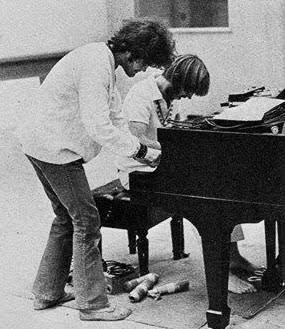

In the studio, 1960s.
Q: “Peter, I've always considered you the most natural musician of the bunch. Is that accurate?”
Peter Tork: “No. The best natural musician in the bunch was Davy. He never hit a bad note. My pitch is not as certain, Micky's isn't as secure. Mike's is, but he doesn't have the emotional range Davy had. Davy could sing Broadway, ballads and rock. He could do anything. What I am, among these guys, is the best trained, the only one who could read and write music. Michael wrote the horn and cello part to ‘Shades of Gray.’ He wrote it in his head, he sang it to me, and I notated it, and I notated it for the French horn. I'm the only one of the four of us who was in possession of that body of information. I took piano for six years and French horn for a couple, plus music theory in college.
And Micky is one of the better pop singers of all time. Not too long ago, I told him, 'You must be one of the top 20 pop singers of all time.' He said, '20?' I said, 'OK, 15.' He said, '15?' I said, 'OK, 10, but that's my best offer.' And Mike Nesmith is extraordinarily rigorous in pitch and time. And he's got imagination, and he's a very hard worker. I'm not. The only thing I have going for me is that I'm trained.”
Micky Dolenz: “Peter also plays more instruments. I only play guitar and, of course, drums when I'm doing a Monkees show. Peter would be the most proficient or knowledgeable about music and playing. He plays guitar, piano, French horn. He plays just about any instrument he picks up. But I'd say Mike is probably the most prolific, in terms of song writing. He is very proficient on guitar, especially that big 12-string he plays all the time.” - Guitar World, July 26, 2013
#Peter Tork#Micky Dolenz#Davy Jones#Michael Nesmith#Tork quotes#60s Tork#10s Tork#Peter and Davy#Peter and Micky#Peter and Michael#Headquarters#long read#can you queue it
33 notes
·
View notes
Text
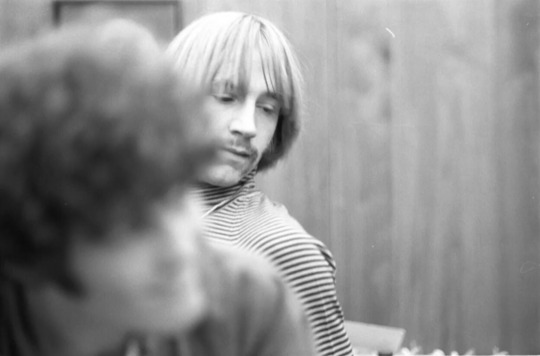


At KCPX in Salt Lake City, May 16, 1968. Photos by Henry Diltz.
"Tork has seen Head around 80 times but it took him years to work out why it bothered him so much. In the movie, the Monkees are hoodwinked, bamboozled, chased, assaulted, mocked, trapped in a black box and reduced to dandruff in the hair of actor Victor Mature, before ending up back where they started. In the words of the sardonic Nicholson-penned theme tune, 'So make your choice and we’ll rejoice/ In never being free.’
'Most people are dazzled by the psychedelia, and that’s fine, but for me finally the point of the movie is the Monkees never get out,’ Tork says sadly. 'Which is to say Bob Rafelson’s view of life is you never get out of the black box you’re in. There’s no escape.’
So how would a Peter Tork cut of Head end?
'There might have been a scene where we get out,’ he says wistfully. 'We jump in the water and get away.’“ - The Guardian, April 28, 2011
76 notes
·
View notes
Photo
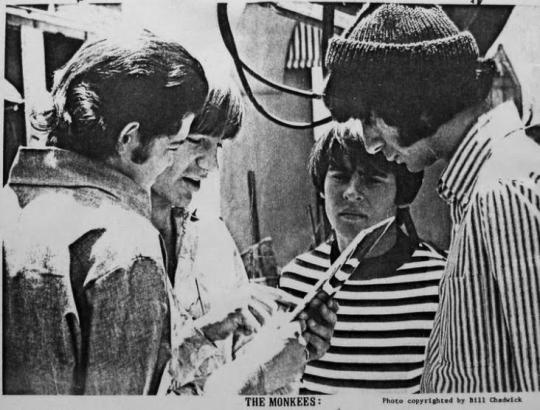
The Monkees (on the set of “It’s A Nice Place To Visit”) perusing Sgt. Pepper’s Lonely Hearts Club Band, 1967. Photo by Bill Chadwick.
“Beatle talk! Whenever he gets the chance, Peter talks to others about the Beatles. He’s quieter off the screen than he seems on and is always very courteous to others.” - Ann Moses, Tiger Beat, January 1967
“Tork related an incident that occurred while he and the Monkees, at the peak of their popularity, were staying at a New York hotel. ‘We were hanging out in a hotel room, and looking down into the street, there was a bunch of kids down there holding a copy of The Beatles‘ Sgt. Pepper album and giving us the finger,’ he said. ‘Hey, we’re Beatles fans too,’ Tork remembers shouting to the group.” - The Central New Jersey Homes News, September 22, 1983
Peter Tork: “[W]hen we were touring in New York, we had a bunch of fans outside the hotel, and over in the corner were a bunch of kids holding up, a small bunch of kids, holding up Sgt. Pepper’s Lonely Hearts Club Band. And we went, ‘Yeah, right, we love that stuff!’ And they went, ‘No, no, you don’t! You guys are awful!’ ‘No, no, we love The Beatles, we are Beatles fans.’ ‘No, you’re not!’”
(laughter)
Q: “Aw.”
PT: “You know, they couldn’t let us like The Beatles because they liked The Beatles, and they didn’t like us, and like that whole thing, friends of my enemies are my enemies, and no middle ground for these people.” - GOLD 104.5, 1999
Q: “What’s the best record you ever heard? The best song? Why?”
Peter Tork: “Album, Sergeant Pepper, probably. Of course, as a Beatles fan, I was ready for every new recording that they put out. Plus the buzz was (cuz) Sgt. Pepper was exceptional, even for the Fab Lads. I remember driving to David Crosby’s house — he had a copy and the great stereo, don’t cha know, and on the way I heard Fixing A Hole on the radio. Even without knowing in advance that it was Paul, I remember thinking how strong a cut it was; only to discover it wasn’t even the strongest cut on the album. Then to sit down in front of the stereo and put the album on, …well! It was one of the great experiences of art I ever hope to have. Song — Lady Madonna. It was just about the beat and the music; sort of like What A Fool Believes, where there’s just that great combination of beat, melody and instruments.” - Beachwood Confidential newsletter, 1995
#Peter Tork#Tork quotes#60s Tork#Davy Jones#Micky Dolenz#Michael Nesmith#The Monkees#Monkees#The Beatles#:)#can you queue it
14 notes
·
View notes
Photo




The Monkees in England, 1989; photo 1 from Harrogate, © Yorkshire Evening Post.
“Peter Tork, for all his coolness, simply gets dragged down by those around him.” - Ian Cheek reviews The Monkees live in Harrogate; Sounds, April 1, 1989
“It was slick and professional right from the opening numbers A Little Bit Me A Little Bit You, Last Train To Clarksville and Pleasant Valley Sunday to Peter Tork’s surprising Appalachian banjo solo.” - Derby Evening Telegraph, April 7, 1989
#The Monkees#Monkees#1989#1980s#80s Tork#Peter Tork#Davy Jones#David Jones#Micky Dolenz#Tork quotes#<3#that first reviewer though ouch#Tork banjo#(if I had a penny for every time a review was 'surprised' by Peter's multi instrumentalist know how...)#Tork reviews#can you queue it
31 notes
·
View notes
Text
Peter Tork in conversation with Maggie McManus, editor of Monkee Business fanzine, on MTV in May 1986.
#Peter Tork#Tork quotes#Maggie McManus#The Monkees#Monkees#80s Tork#Monkees fans#Monkee Business fanzine#can you queue it
24 notes
·
View notes